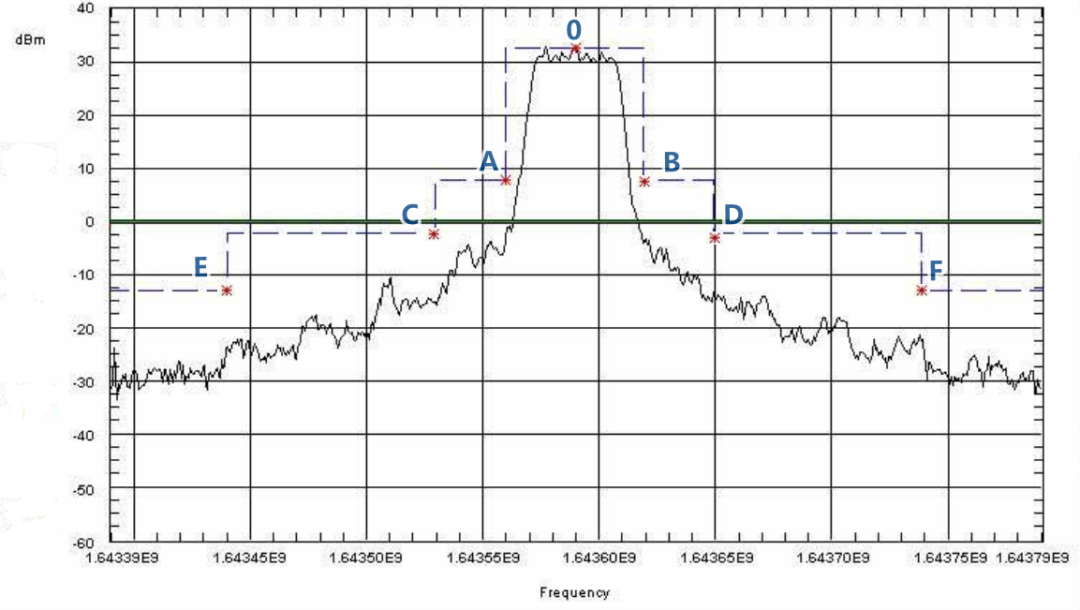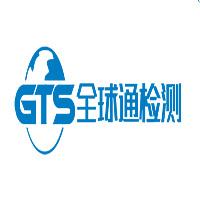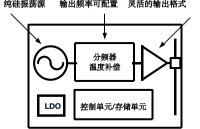今天我們接著來看Part 25.202的頻率容差和發射限值。
01
頻率容限
(d) Frequency tolerance, Earth stations. The carrier frequency of each earth station transmitter authorized in these services shall be maintained within 0.001 percent of the reference frequency.
(e) Frequency tolerance, space stations. The carrier frequency of each space station transmitter authorized in these services shall be maintained within 0.002 percent of the reference frequency.
以上是FCC關于頻率容限(Frequency tolerance)的定義原文。對于地球站和空間站的要求是不同的,分別為參考頻率的百分之0.001和百分之0.002,在很多報告上,也往往這樣來寫:地球站和空間站的頻率容差限值分別為10ppm和20ppm,ppm為10^-6,與百分比的表示方法是等效的。其計算公式為(Fmeasured? Freference)/Freference。
Part25.202中只給出了頻率容限的技術要求,并沒有具體規定測量方法。但我們在一些報告中可以看到,這個頻率容限,測量的是載波頻率在不同溫度和不同供電電壓條件下的頻率穩定度。例如下表中,溫度從-30度~+50度;主電源電壓在額定值的±15%之間變化(手提電池設備除外)。

02
發射限值
發射限值分為五個部分:
除了SDARS地面中繼器和下面第4點規定的情況之外,應按照以下(1)-(4)規定的模板來進行發射平均功率的調整:
(1) In any 4 kHz band, the center frequency of which is removed from the assigned frequency by more than 50 percent up to and including 100 percent of the authorized bandwidth: 25 dB;
(2) In any 4 kHz band, the center frequency of which is removed from the assigned frequency by more than 100 percent up to and including 250 percent of the authorized bandwidth: 35 dB;
(3) In any 4 kHz band, the center frequency of which is removed from the assigned frequency by more than 250 percent of the authorized bandwidth: An amount equal to 43 dB plus 10 times the logarithm (to the base 10) of the transmitter power in watts;
(4) In any event, when an emission outside of the authorized bandwidth causes harmful interference, the Commission may, at its discretion, require greater attenuation than specified in paragraphs (f) (1), (2) and (3) of this section.
以上是25.202中頻譜發射模板的標準原文,不枉我們曾說的,看過FCC的標準之后,還是更希望被3GPP的表格來虐吧。我們使用下面的一張圖例來了解一下頻譜發射模板限值,就一目了然了:

首先,in any 4kHz band是指我們測試中所用到的測量帶寬是4kHz(Measurementbandwidth),圖中的0點即為中心頻率點(center frequency),(1)從A點(或對稱點B)開始即為將分配的頻率除外,從授權帶寬的50%開始計算直到100%帶寬的C點(或對稱點D),限值要求為比0點功率下降25dB;(2) C點(或對稱點D)是從授權帶寬的100%開始計算直到250%帶寬的E點(或對稱點F),限值要求為比0點功率下降35dB;(3) 為250%帶寬以上頻率的限值要求為比0點功率下降43dB+10×log(Tx Power in W);(4)在任何情況下,當授權帶寬以外的發射造成有害干擾時,FCC可酌情要求比上述(1)、(2)和(3)段規定的衰減更大。
最后我們再用表格的方式總結一下:

2. 遙測、跟蹤和指令信號,也就是我們上次講到過的TT&C:FCC衛星通信頻率劃分-Part25.202,可以在指定頻段內不在頻段邊緣的頻率上傳輸,但條件是,與衛星網絡上的通信流量相比,這些傳輸不會造成更大的干擾,也不需要更多的保護來防止有害干擾,或者已經與指定軌道位置6度范圍內的授權同頻空間站的運營商進行了協調。這里的意思是說TT&C應該不需要測試帶外限值。
3. SDARS地面中繼器的帶外發射限值:首先解釋一下SDARS,通常的衛星數字音頻廣播業務是利用靜止軌道通信衛星向地球用戶提供相關業務服務,在美國叫做SDARS(Satellite Digital Audio Radio Service):衛星數字音頻無線電業務。
(1) Any SDARS terrestrial repeater operating at a power level greater than 2-watt average EIRP is required to attenuate its out-of-band emissions below the transmitter power P by a factor of not less than 90 + 10 log (P) dB in a 1-megahertz bandwidth outside the 2320-2345 MHz band, where P is average transmitter output power in watts.
(2) Any SDARS terrestrial repeater operating at a power level equal to or less than 2-watt average EIRP is required to attenuate its out-of-band emissions below the transmitter power P by a factor of not less than 75 + 10 log (P) dB in a 1-megahertz bandwidth outside the 2320-2345 MHz band, where P is average transmitter output power in watts.
(3) SDARS repeaters are permitted to attenuate out-of-band emissions less than the levels specified in paragraphs (h)(1) and (h)(2), of this section unless a potentially affected WCS licensee provides written notice that it intends to commence commercial service within the following 365 days. Starting 180 days after receipt of such written notice, SDARS repeaters within the area notified by the potentially affected WCS licensee must attenuate out-of-band emissions to the levels specified in paragraphs (h)(1) and (h)(2) of this section.
(4) For the purpose of this section, a WCS licensee is potentially affected if it is authorized to operate a base station in the 2305-2315 MHz or 2350-2360 MHz bands within 25 kilometers of a repeater seeking to operate with an out of band emission attenuation factor less than those prescribed in paragraphs (h)(1) or (2) of this section.
(i) The WCS licensee is authorized to operate a base station in the 2305-2315 MHz or 2350-2360MHz bands in the same Major Economic Area (MEA) as that in which a SDARS terrestrial repeater is located. (ii) The WCS licensee is authorized to operate a base station in the 2315-2320 MHz or 2345-2350MHz bands in the same Regional Economic Area Grouping (REAG) as that in which a SDARS terrestrial repeater is located. (iii) A SDARS terrestrial repeater is located within 5 kilometers of the boundary of an MEA or REAG in which the WCS licensee is authorized to operate a WCS base station.
以上是SDARS的帶外發射限值原文,我們同樣用表格的方式表示如下:

但卻有一些針對SDARS的特殊情況考慮如下:
首先,在以下情況下,允許SDARS中繼器的帶外輻射超出上述表格規定的水平:即可能受影響的WCS(Wireless CommunicationsService)持牌人提供書面通知,說明其打算在隨后的365天內開始商業服務。但從收到這種書面通知的180天開始,在可能受影響的WCS持牌人通知的區域內的SDARS中繼器必須將帶外輻射水平降至此表中規定的水平。
其次,如果WCS持證人被授權在2305-2315Hz或2350-2360MHz頻段內運營基站,而該距離基站25公里范圍內的SDARS中繼器,以高于上表中規定的帶外發射進行操作,則WCS可能會受到影響。(i)WCS被授權在與SDARS地面中繼器所在的主要經濟區(MEA)相同的2305-2315MHz或2350-2360MHz頻段內運營一個基站。
(ii)WCS被授權在與SDARS地面中繼器所在的同一區域經濟區分組(REAG)內的2315-2320MHz或2345-2350MHz頻段內運營一個基站。(iii) SDARS地面中繼器位于MEA或REAG邊界的5公里范圍內,而WCS許可證持有者在該邊界內被授權運營WCS基站。
4. 根據ITU-R通信局收到完整的預先公布信息的日期,在22.55-23.55GHz頻段內發射的非對地靜止衛星服務中運行的下列無用發射功率限值應適用于23.6-24GHz無源頻段的任何200MHz。這里同樣是來自于ITU-R的針對無源業務EESS保護的限值要求,但相比于5G NR毫米波基站的IMT頻段的要求要更嚴格。

5. 對于在49.7-50.2GHz和50.4-50.9GHz頻段內發射的FSS固定衛星服務(地對空)的地面站,50.2-50.4GHz頻段內的無用發射功率不得超過-20dBW/200MHz(在天線輸入端測量),但對于天線增益大于或等于57dBi的地面站,最大無用發射功率可提高到-10dBW/200MHz。這些限值適用于晴空條件下。在衰落條件下,地面站在使用上行鏈路功率控制時可能會超過這些限值。

審核編輯:劉清
-
中繼器
+關注
關注
3文章
380瀏覽量
28214 -
電源電壓
+關注
關注
2文章
987瀏覽量
23946 -
FCC
+關注
關注
0文章
201瀏覽量
25839
原文標題:FCC衛星通信-頻率容限及發射限值-Part25.202
文章出處:【微信號:無線通信標準解讀,微信公眾號:無線通信標準解讀】歡迎添加關注!文章轉載請注明出處。
發布評論請先 登錄
相關推薦
六類非屏蔽網線滿足fcc認證嗎
北美FCC認證的申請條件:產品技術要求分享

pwm驅動電機對頻率有啥要求
北美FCC認證中包含哪些測試項目?

FCC大電流注入探頭f-52b的使用方法分享

產品如何進軍北美市場?北美FCC認證指南

平板電腦申請北美FCC認證的流程有哪些?

無線鼠標的FCC認證難點有哪些?

美國FCC發布無線充設備WPT的新要求KDB680106 D01

北美FCC認證相關介紹以及申請周期分享

美國FCC最新標準(HAC 2019),2023年12月5日起實施





 FCC關于頻率容限的要求
FCC關于頻率容限的要求














評論